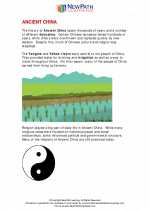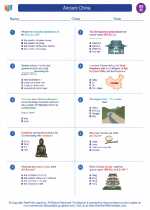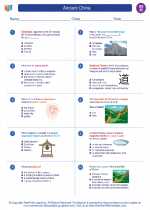Confucianism Study Guide
Historical Background
Confucianism originated in ancient China during a time of political and social upheaval. Confucius sought to provide solutions to the moral and social problems of his time through his teachings.
Key Concepts
- Ren (仁): This is often translated as "benevolence" or "humaneness" and represents the ideal of being a good and kind person.
- Li (礼): This refers to the observance of rituals, proper conduct, and etiquette in various social interactions.
- Xiao (孝): This concept emphasizes filial piety and respect for one's parents and ancestors.
- Junzi (君子): The "gentleman" or "noble person" who embodies moral integrity, wisdom, and exemplary conduct.
Influence on Society
Confucianism has had a profound impact on various aspects of East Asian societies, including family structure, education, government, and social relationships.
Comparison with other Philosophies
Compare and contrast Confucianism with other philosophical traditions such as Daoism and Legalism, highlighting their differences in beliefs and values.
Modern Relevance
Explore how Confucian values and principles continue to influence contemporary East Asian societies, as well as their impact on global cultural and ethical discourse.
◂Social Studies Worksheets and Study Guides Eighth Grade. Ancient China
Study Guide Ancient China
Ancient China  Worksheet/Answer key
Worksheet/Answer key Ancient China
Ancient China  Worksheet/Answer key
Worksheet/Answer key Ancient China
Ancient China  Worksheet/Answer key
Worksheet/Answer key Ancient China
Ancient China 

 Worksheet/Answer key
Worksheet/Answer key
 Worksheet/Answer key
Worksheet/Answer key
 Worksheet/Answer key
Worksheet/Answer key

The resources above cover the following skills:
National Curriculum Standards for Social Studies (NCSS)
TIME, CONTINUITY, AND CHANGE
SOCIAL STUDIES PROGRAMS SHOULD INCLUDE EXPERIENCES THAT PROVIDE FOR THE STUDY OF THE PAST AND ITS LEGACY.
KNOWLEDGE - Learners will understand:
Key historical periods and patterns of change within and across cultures (e.g., the rise and fall of ancient civilizations, the development of technology, the rise of modern nation-states, and the establishment and breakdown of colonial systems).
National Center for History in Schools (NCHS)
Historical Thinking Standards
Historical Comprehension
Reconstruct the literal meaning of a historical passage.
United States History Content Standards
Era 1: Three Worlds Meet (Beginnings to 1620)
How early European exploration and colonization resulted in cultural and ecological interactions among previously unconnected peoples.
The student understands the stages of European oceanic and overland exploration, amid international rivalries, from the 9th to 17th centuries.
World History Content Standards
Era 2: Early Civilizations and the Emergence of Pastoral Peoples, 4000-1000 BCE
How agrarian societies spread and new states emerged in the third and second millennia BCE.
The student understands how civilization emerged in northern China in the second millennium BCE.
The political, social, and cultural consequences of population movements and militarization in Eurasia in the second millennium BCE.
The student understands the social and cultural effects that militarization and the emergence of new kingdoms had on peoples of Southwest Asia and Egypt in the second millennium BCE.
Major trends in Eurasia and Africa from 4000-1000 BCE.
The student understands major trends in Eurasia and Africa from 4000 to 1000 BCE.
Era 3: Classical Traditions, Major Religions, and Giant Empires, 1000 BCE-300 CE
How major religions and large-scale empires arose in the Mediterranean basin, China, and India, 500 BCE-300 CE.
The student understands how China became unified under the early imperial dynasties.
Major global trends from 1000 BCE-300 CE.
The student understands major global trends from 1000 BCE to 300 CE.
Era 4: Expanding Zones of Exchange and Encounter, 300-1000 CE
Imperial crises and their aftermath, 300-700 CE.
The student understands the decline of the Roman and Han empires.
The student understands the expansion of Christianity and Buddhism beyond the lands of their origin.
The student understands the expansion of Hindu and Buddhist traditions in Southeast Asia in the first millennium CE.
Era 5: Intensified Hemispheric Interactions 1000-1500 CE
The maturing of an interregional system of communication, trade, and cultural exchange in an era of Chinese economic power and Islamic expansion.
The student understands how interregional communication and trade led to intensified cultural exchanges among diverse peoples of Eurasia and Africa.
Major global trends from 1000-1500 CE.
The student understands major global trends from 1000 to 1500 CE.